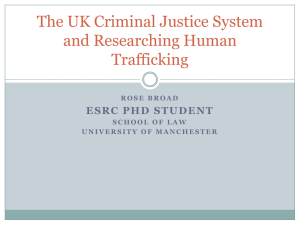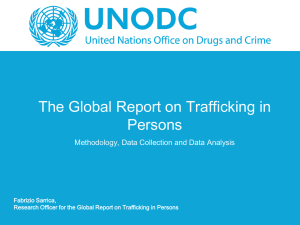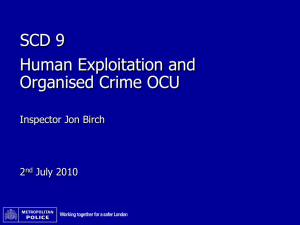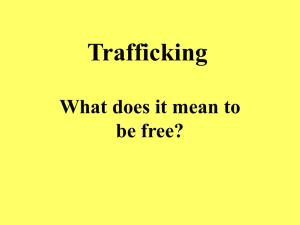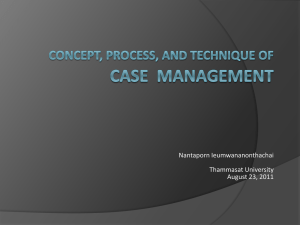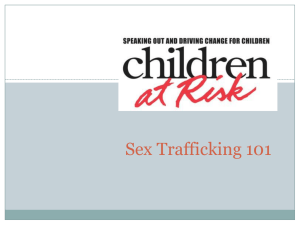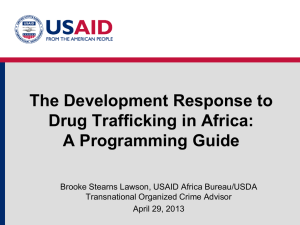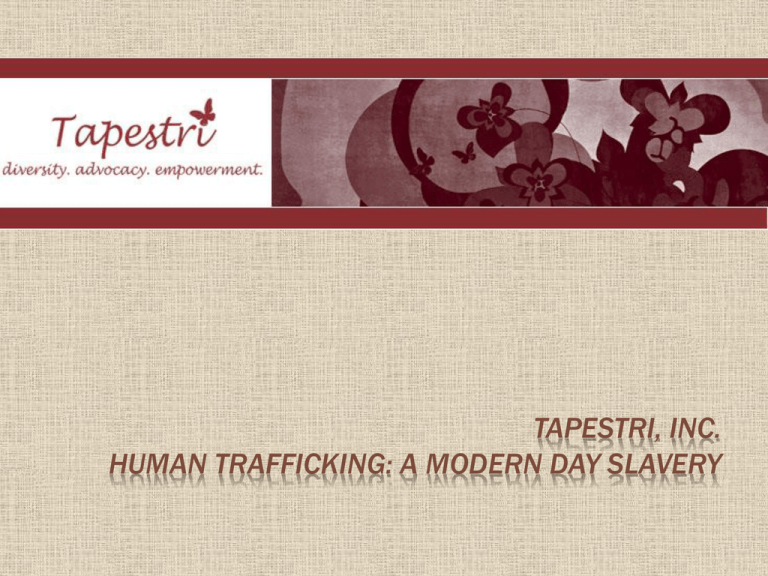
TAPESTRI, INC.
HUMAN TRAFFICKING: A MODERN DAY SLAVERY
TAPESTRI
INTRODUCTION
Tapestri, Inc. is dedicated to ending violence
and oppression in refugee and immigrant
communities, using culturally competent and
appropriate methods
Tapestri Services:
Direct services to Victims of Human Trafficking.
Legal Advocacy for Domestic Violence Survivors
Family Violence Intervention Program
Community Education & Outreach (Trainings
and Materials)
DEFINITION OF HUMAN
TRAFFICKING
US law defines human trafficking as:
The recruitment, abduction, transport,
harbouring, transfer, sale or receipt of
persons for the purpose of exploitation.
ALIEN SMUGGLING VS. HUMAN
TRAFFICKING
When someone is brought into
the country, they pay for the
service of being smuggled, and
are free to go afterwards. This
is alien smuggling. It is illegal,
but it is a service in which the
customer is not exploited.
When someone is brought into
the country, voluntarily or
involuntarily, legally or illegally,
for the purpose of exploitation
or extortion this would
constitute human trafficking.
HUMAN TRAFFICKING VS. LABOR
EXPLOITATION
Both Human Trafficking and Labor
exploitation are “exploitive” in
nature.
However, if a person is working
and/or living in an exploitive
situation but is free to go at any
time this would not constitute
trafficking.
If a person is being exploited AND
is coerced and/or forced into
enduring that situation, then this
would constitute human
trafficking.
FACTS ABOUT TRAFFICKING
Trafficking in persons is the second
largest and fastest growing criminal
industry in the world.
It is a billion dollar industry and
victimizes millions of people.
It has been reported that 161
countries are affected by human
trafficking by being the source,
transit or destination country
About 14,500- 17,500 people are
trafficked into the United States
every year.
WHO ARE THE POTENTIAL
TRAFFICKING VICTIMS?
Anyone can be a potential
victim of human trafficking.
In the United States
trafficked individuals are
found from all over the
world, especially, but not
only, from economically
depressed countries.
Primarily women and
children
PEOPLE TRAFFICKED BY REGION
WHO ARE THE TRAFFICKERS?
Organized crime rings
Corporations who practice labor
exploitation
Loosely organized crime rings
Family based crime rings
Individuals
Most trafficked individuals are trafficked by
people from their own country.
WHO ARE THE TRAFFICKERS?
Amador Cortes-Meza
Sex Trafficking
Sex Trafficking
Partner
WHO ARE THE TRAFFICKERS?
The Hamilton Ring
Labor Trafficking
Bidemi Bello
Diplomat – Domestic
Servitude
THE TRAFFICKERS IN NUMBERS
52%
of traffickers are men, 42% are women
and 6% are both men and women
In
54% of cases the trafficker was a stranger
to the victim, 46% of cases the trafficker was
known to victim
The
majority of traffickers are from the same
country as the victims
WHY DOES HUMAN TRAFFICKING OCCUR?
Extremely Profitable
Human “merchandise” can be reused over and
over again
Not an easily identifiable crime
Involves little risk for the traffickers so they can
operate with impunity
In 2010 there were only 6,017 prosecutions and
3,619 convictions throughout the world which
means that almost half of the traffickers were not
convicted (TIP 2011)
HOW ARE TRAFFICKED PERSONS
RECRUITED?
The trafficked individual is often promised a good
job, better pay, education, marriage, or simply better
opportunities for themselves and their families.
Traffickers entice their victims through word-ofmouth, newspaper and telephone book ads,
brochures, Web sites and fake or dubious
employment, adoption or mail-order bride agencies
Trafficked individuals might be kidnapped.
They may even be sold by a relative.
TYPES OF EXPLOITATION
Sex Trafficking
(prostitution, pornography, sex tourism…)
Domestic servitude
(housekeeper, nanny, servant…)
Servile marriage (servant)
Labor Trafficking (other forms)
(Employment visas, sweatshops, restaurants,
agricultural work, manual labor …)
CONTROL FACTORS COMMON IN
HUMAN TRAFFICKING
1.
Psychological Coercion (*extremely powerful)
Creating a sense of dependency on the
trafficker
Threats of violence against family members or
friends
Fabricated and exaggerated travel debt.
Creating an irrational fear of BCIS (former INS)
Threat of deportation.
Confiscating the victim’s documentation
CONTROL FACTORS COMMON IN
HUMAN TRAFFICKING (CONT.)
2. Physical Force:
Isolation
Imprisonment
Punching
Hitting
Beating
Rape
Sexual Abuse
Incarceration
Denial of Food
Sleep Deprivation
Denial of Medical
Care
BARRIERS TO SEEKING HELP
1. Language:
When the trafficked individual does not
speak the language of the host country it
makes it harder for that individual to
escape or seek help.
2. Culture:
In many cultures even the concept of “human trafficking
does not exist.
* Shame/stigma
3. Economic/Survival:
Often if the victims escape they will automatically
become homeless with left without any support.
BARRIERS TO SEEKING HELP (CONT.)
4. Lack of Knowledge:
Trafficked individual does not know what 911 is or that
it even exists.
Have an exaggerated fear of getting deported that he or
she may be very hesitant to call or trust the police.
Does not know that there are laws to protect them or
help available for them.
5. Isolation:
Isolated twice, once in the physical space provided by
the traffickers and a second time because this space is
often within an ethnic enclave that is hard to reach by
service providers, media, and law enforcement.
Not even know where they are.
RED FLAGS FOR POTENTIAL VICTIMS OF
TRAFFICKING
Answers appear to be scripted and rehearsed – Or
Inconsistencies in story
Was recruited through false promises concerning the
nature and conditions of his/her work
Is unpaid, paid very little, or paid only through tips
Is fearful, anxious, depressed, tense, nervous / paranoid
behavior or stupor like behavior (mental or emotional
numbness)
They also may appear submissive – will not speak up
The individual does not have any personal identification
papers, passport, visa, etc.
RED FLAGS FOR POTENTIAL VICTIMS OF
TRAFFICKING (CONT.)
Signs of physical or psychological abuse
Another person speaks for them
Someone else handles their money – may be a third
party that handles the money
Works odd/long hours or works 7 days a week
Untreated illness or infections
Bands, scarring or tattoos indicating ownership –
pimps are known to brand their girls
No knowledge of local community
Fear law enforcement or local authority
Children living with someone who is not related to them
RED FLAGS FOR MINORS VICTIMS OF
TRAFFICKING
Talk about an older boyfriend or sex with an older
man/boyfriend or,
Presence of an overly controlling and abusive
“boyfriend”
Excess amount of cash
Lying about age/false identification
Inability or fear to make eye contact
Claims of being an adult although appearance
suggests adolescent features
IDENTIFYING A VICTIM OF TRAFFICKING
•The complex patterns of human trafficking can create
tremendous challenges to identification of victims. There
isn't an specific question that will immediately alarm you
that this is a trafficking survivor
•When first talking to a potential victim try to make the
victim as comfortable as possible.
•Allow the victim to first tell you their full story before asking
questions.
•Rather then using terms like “Human Trafficking” explain
the concept of it.
•Reassure that you are here to help her and that there are
laws to protect her.*
•Only get the information you need when talking to a victim
to avoid revictimization or possibly getting subpoena during
prosecution.
IDENTIFYING A VICTIM OF TRAFFICKING
Are people charging others
for the victims services and
keeping the money?
Can they leave their job if
they want to?
Are they being forced to do
things against their will?
Are they being overworked?
Are they being made to pay
off a debt?
Are they being threatened
with deportation?
Do they feel like a prisoner?
Do they get punished for
complaining about their work
or living conditions?
Do they get in trouble if they
go out by themselves or talk
to whomever they want to?
Do they feel they are in
danger?
IDENTIFYING A CHILD VICTIM OF HUMAN
TRAFFICKING
A person below the age of 18 who has been
recruited, transferred, harbored or received for
the purpose of exploitation.
The child does not have to have been
threatened, forced, abducted, deceived,
abused or sold to be identified as trafficking
survivor.
IMMIGRATION RELIEF
Continued Presence:
This is a form of immigration relief that federal law
enforcement can apply for on behalf of the victim.
It grants victims who cooperate in investigation or
prosecution the same benefits and rights of a T-Visa
recipient.
It lasts for one year and is renewable by undefined
period of time.
Once you have a continued presence you can also apply
for a T-Visa.
Once Cp is granted ORR will be notified and issue an
Eligibility Letter that will allow victim to access same
benefits as Refugees.
IMMIGRATION RELIEF (CONT.)
T-VISA:
Trafficking Victims Protection Act, 2000
Requirements:
Be a victim of a “severe form” of trafficking
Be a person of good moral character
Be willing to comply with any reasonable request for
assistance in the investigation during the three-year
period the visa will last.
Face severe and unusual hardship if returned to
country of origin.
SERVICES AVAILABLE TO VICTIMS AT
TAPESTRI
Crisis counselling.
Securing access to medical, dental and mental
health services.
Securing access to emergency housing.
Providing emergency clothing and food for victims.
Providing victims with education related to everyday life skills in the U.S. (i.e. how to use public
transportation, banking, money management, etc.)
Transportation to appointments.
Assisting victims in accessing public benefits.
SERVICES AVAILABLE TO VICTIMS AT
TAPESTRI
Providing interpretation services for victims and
assisting them in translating affidavits or any other
documents that would assist their case.
Providing information and education on legal, civil,
criminal, and immigration options for victims.
Securing pro bono legal services for victims.
Assisting victims in filing for certification and legal
immigration status.
Supporting victims through the investigation
process.
What Can You Do?
Human trafficking is
such a complex issue
that all agencies and
community members
need to get involved in
stopping this crime.
WHAT CAN YOU DO?
Help spread awareness of the issue.
If you identify a victim give them our
information and refer them to Tapestri .
Provide information to assist law enforcement
with investigation and prosecution of this
crime.
Give a second look at people providing you
services or those arrested as “criminals”.
Perhaps they may be a victim of human
trafficking.
CONTACT US
Atlanta/Metro Atlanta Hotline:
404-299-0895
Nationwide Hotline:
1-866-317-FREE (3733)
Office: (404) 299-2185
E-Mail: jadma@tapestri.org
Website: www.tapestri.org



